All stars follow the same basic series of steps in their lives:
Gas Cloud ![]() Main Sequence
Main Sequence
![]() Red Giant
Red Giant ![]() (Planetary Nebula or Supernova)
(Planetary Nebula or Supernova)
![]() Remnant. How long a star
lasts in each stage, whether a planetary nebula forms or a spectacular
supernova occurs, and what type of remnant will form depends on
the initial mass of the star.
Remnant. How long a star
lasts in each stage, whether a planetary nebula forms or a spectacular
supernova occurs, and what type of remnant will form depends on
the initial mass of the star.
A giant molecular cloud is a large, dense gas cloud (with dust) that is cold enough for molecules to form. Thousands of giant molecular clouds exist in the disk part of our galaxy. Each giant molecular cloud has 100,000's to a few million solar masses of material.
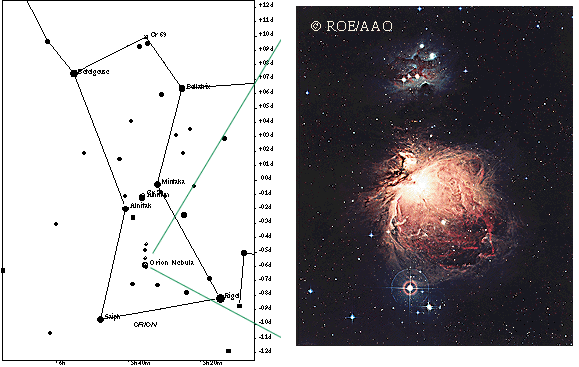
One nearby example is the Orion Molecular Cloud Complex that stretches from the belt of the Orion constellation to his sword of which the Orion Nebula is a part. The Orion Complex is about 1340 light years away, several hundred light years across, and has enough material to form many tens of thousands of suns. The giant molecular clouds have dust in them to shield the densest parts of them from the harsh radiation of nearby stars so that molecules can form in them. Therefore, they are very dark and very cold with a temperature of only about 10 K. In addition to the most common molecule, molecular hydrogen, over 80 other molecules have been discovered in the clouds from simple ones like carbon monoxide to complex organic molecules such as methanol and acetone. Radio telescopes are used to observe these very dark, cold clouds. The clouds are dense relative to the rest of the gas between the stars but are still much less dense than the atmosphere of a planet. Typical cloud densities are 100 to 1000 molecules per cubic centimeter while each cubic centimeter of the air you breath has about 2.5 × 1019 molecules---a molecular cloud is tens to hundreds of times "emptier" than the best vacuum chambers we have on Earth!
In the parts of a giant molecular cloud where very hot stars (O and B-type) have formed, the hydrogen gas surrounding them can be made to glow in the visible band to make what is called a H II region. The Orion Nebula is an example of this. It is the fuzzy patch you can see in the sword part of the Orion constellation. It is a bubble about 26 light years across that has burst out of one side of the Orion Complex.
The nebula is lit up by the fluorescence of the hydrogen gas around a O-type star in the Trapezium cluster of four stars at the heart of the nebula. The O-type star is so hot that it produces a large amount of ultraviolet light. The ultraviolet light ionizes the surrounding hydrogen gas. When the electrons recombine with the hydrogen nuclei, they produce visible light. Several still-forming stars are seen close to the Trapezium stars. They appear as oblong blobs in the figure below with their long axis pointed toward the hot Trapezium stars. If you select the image, an expanded view of the Trapezium cluster will appear in another window. Both images are from the Hubble Space Telescope (courtesy of Space Telescope Science Institute).
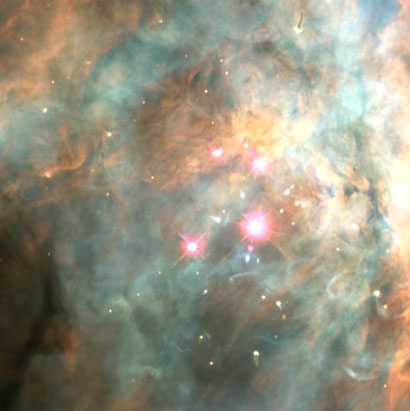
H II regions mark sites of star formation because they are formed by hot, young stars. Recall from the table at the beginning of the chapter that O-type stars live just a few million years, a very short time for a star! They do not live long enough to move out from where they were formed. Behind the visible part of the Orion Nebula is a much denser region of gas and dust that is cool enough for molecules to form. Several hundred stars are now forming inside the Orion Nebula.
Fragments of giant molecular clouds with tens to hundreds of solar masses of material a piece will start collapsing for some reason all at about the same time. Possible trigger mechanisms could be a shock wave from the explosion of a nearby massive star at its death or from the passage of the cloud through regions of more intense gravity as found in the spiral arms of spiral galaxies. These shock waves compress the gas clouds enough for them to gravitationally collapse. Gas clouds may start to collapse without any outside force if they are cool enough and massive enough to spontaneously collapse. Whatever the reason, the result is the same: gas clumps compress to become protostars.
A protostar will reach a temperature of 2000 to 3000 K, hot enough to glow a dull red with most of its energy in the infrared. The cocoon of gas and dust surrounding them blocks the visible light. The surrounding dust warms up enough to produce copious amounts of infrared and the cooler dust further out glows with microwave energy. This longer wavelength electromagnetic radiation can pass through the dust. The infrared telescopes are able to observe the protostars themselves and their cocoons in dust clouds in our galaxy while the microwave telescopes probe the surrounding regions. The power of infrared detectors is illustrated in the images below. The part of the nebula above and to the right of the Trapezium stars is actually forming many stars. They can only be seen in the infrared images on the right side of the figures. If you select the figures, an expanded view will appear in another window. Both images (right and left) are from the Hubble Space Telescope (courtesy of Space Telescope Science Institute). Also check out the visible light (HST) - infrared (Spitzer) tour video of the Orion Nebula.
 --
--
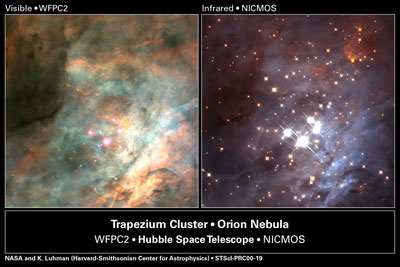
The low-mass protostars (those up to about 5 solar masses) are initially much more luminous than the main sequence star they will become because of their large surface area. As these low-mass protostars collapse, they decrease in luminosity while staying at roughly a constant surface temperature. A star remains in the protostar stage for only a short time, so it is hard to catch many stars in that stage of their life. More massive protostars collapse quicker than less massive ones. Fusion starts in the core and the outward pressure from those reactions stops the core from collapsing any further. But material from the surrounding cloud continues to fall onto the protostar. Most of the energy produced by the protostar is from the gravitational collapse of the cloud material.
Young stars are social---fragmentation of the giant molecular cloud produces protostars that form at about the same time. Stars are observed to be born in clusters. Other corroborating evidence for this is that there are no isolated young stars. This observation is important because a valuable test of the stellar evolution models is the comparison of the models with star clusters. That analysis is based on the assumption that the stars in the clusters used to validate the models all formed at about the same time.
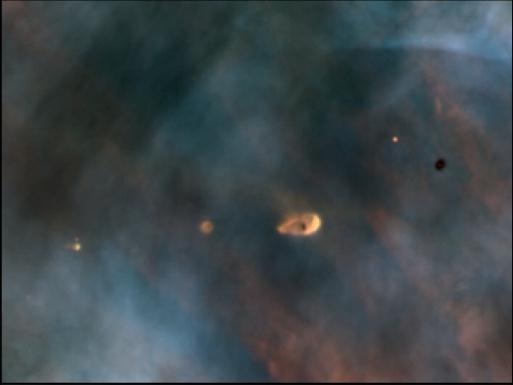
The Hubble Space Telescope has directly observed protostars in the Orion Nebula and the Eagle Nebula (in the Serpens constellation). The protostars it has observed have been prematurely exposed. The intense radiation from nearby hot O or B-type stars has evaporated the dust and driven away the gas around the smaller still-forming stars. In more than one case in the Orion Nebula, all of the gas has been blown away to leave just the dark dust disk with the protostar in the center. One example of a totally exposed dust disk seen almost face-on is shown in the figure above. It is the black spot to the right of the prominent cocoon nebula around the protostar at the center. The teardrop-shaped cocoon nebula around the center protostar is oriented toward the Trapezium stars to the right of the figure above. The evaporation of the dark, dense fingers of dust and gas in the Eagle Nebula was captured in the famous ``gas pillars'' picture on the right side of the figure below. Selecting the figure will bring up an expanded view of the Hubble Space Telescope image in another window (courtesy of Space Telescope Science Institute). Note that the tiniest fingers you see sticking out of the sides of the pillars are larger than our entire solar system!
A nice interactive showing how the iconic "Pillars of Creation" image from HST was created from putting together various filter images is the The Pillars of Creation interactive from NOVA's Origins series that was broadcast on PBS (selecting the link will bring it up in another window).
Another beautiful example from the Hubble Space Telescope is the huge panoramic image of the Carina Nebula released by the Space Telescope Science Institute in mid-2007. This nebula has at least a dozen stars that are 50 to 100 times the mass of the Sun and plenty of Bok globules, pillars, jets from forming stars. For this one you need to sample various parts of the image available from the link. The image below of one pillar in the Carina Nebula in visible and infrared light provides another illustration of the usefulness of infrared observations to peer inside the dust clouds. Note the large number of stars that can be seen in the infrared! Also notice the bipolar jets coming from young stars at the tips of some of the modules. The young stars are in the T-Tauri stage described in the next section.
Below is one of the first images released from the James Webb Space Telescope in 2022: a section in the northwest corner of the Carina Nebula called NGC 3324 taken in the near-infrared. The intense ultraviolet and strong stellar winds from hot O and B-type stars has carved out a cavern in the nebula. Denser pillars resist this erosion. Many stellar nurseries and young stars hidden by the dust in the visible band are seen in the infrared. Webb will be able help us determine the influence of the more numerous smaller stars on their neighbors in the formation process---something that has been mostly hidden from us before. Because Webb sees just in the infrared, all of the infrared colors are shifted (translated) into the visible band for the human eye to see them.
Below is a comparison of Webb's view of NGC 3324 with the Hubble Space Telescope's view in the visible band released in 2008. The Webb release image has been cropped to more closely match the view from Hubble. See the WebbCompare website for a slick interface overlap of the two images plus comparisons of other objects such as the Cartwheel Galaxy, Southern Ring Nebula, the galaxy cluster SMAC 0723, and Stephan's Quintet.
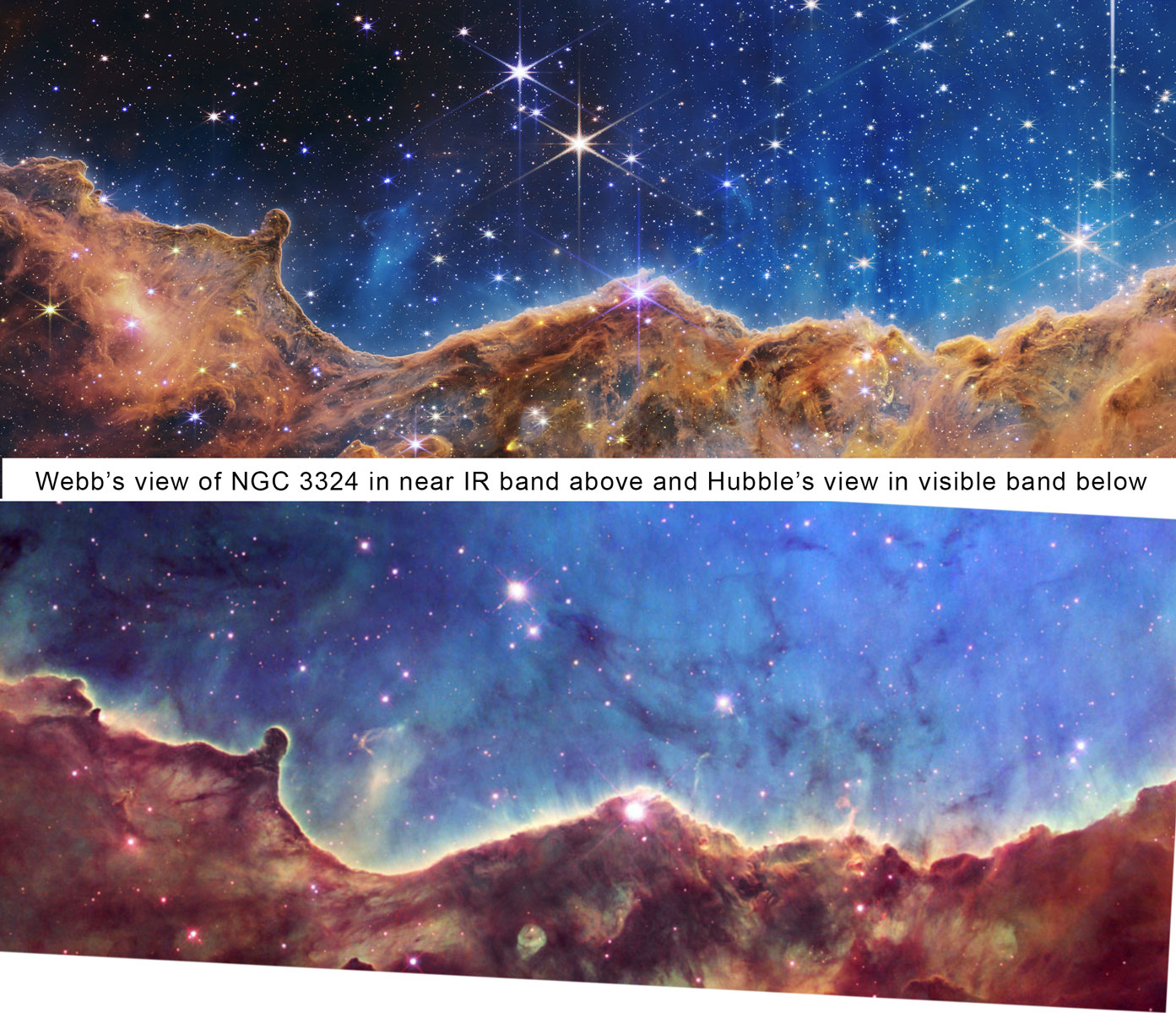
The final image of this set is a composite from Webb using its NIRCam (near-infrared) with its Mid-Infrared Instrument (MIRI) which also includes a scale bar, compass orientation, and the infrared filter translations to visible band. Young stars and planet-forming disks shine brightly in the mid-infrared, and the infrared colors are shifted so that the disks glowing in the mid-infrared appear pink and red in the image. Hydrocarbons and other chemical compounds on the surfaces glow in the mid-infrared. MIRI is able to reveal the forming stars that produce the jets and outflows that are infrared-shifted to visible band gold.
![]() Go back to previous section --
Go back to previous section --
![]() Go to next section
Go to next section
last updated: August 3, 2022